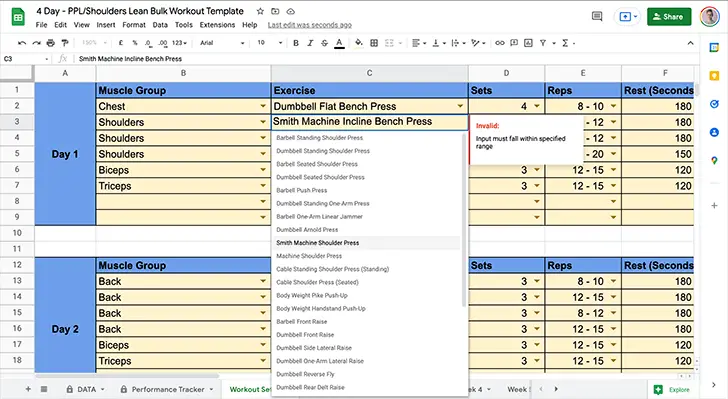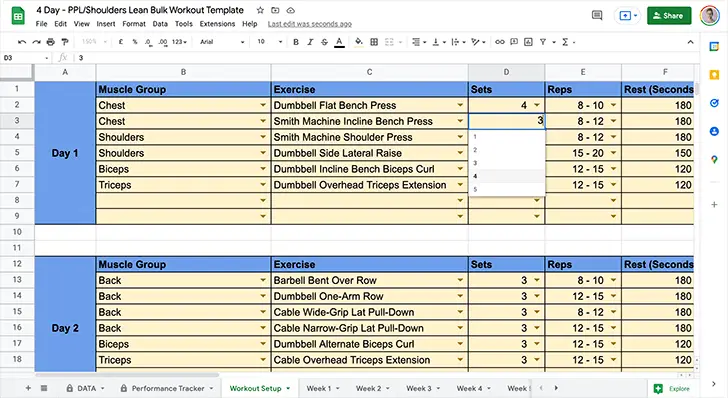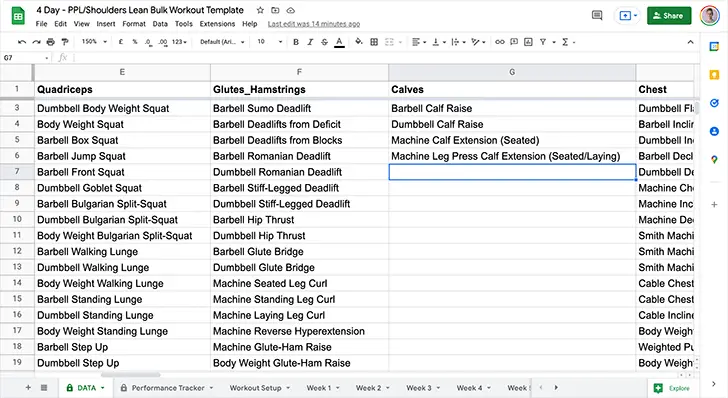12-Week Lean Bulk Workout Plan
Are looking for a new lean bulk workout plan because the current one that you’re following isn’t giving you the results that you want?
Most of us are looking to build lean muscle with minimal body fat, but most workout plans just don’t deliver. You end up spending hours in the gym every week and still not seeing any progress.
This article showcases 12-week lean bulk workout programs that will help you get stronger and add lean body mass without adding unnecessary body fat.
It also outlines key aspects a proper workout routine should follow and provides you access to free lean bulk workout plans that you can customize to suit your needs. These workout plans are suited for novice/intermediate and more experienced lifters.
In this article you will find:
- 12 Week Lean Bulk Workout Plans
- How to Use Lean Bulk Workout Plan Template
- Tips When Following Lean Bulk Workout Plan
- Frequently Asked Questions About Lean Bulk Workout Plan
12 Week Lean Bulk Workout Plans
Four different workout plans are demonstrated below:
- 2-3 Day – Full-Body Workout Plan
- 4 Day – Upper/Lower Workout Plan
- 4 Day – Push/Pull/Legs/Shoulders Workout Plan
- 6 Day – Push/Pull/Legs Workout Plan
You can pick the one that is the most suited for your resistance training experience and daily schedule.
You can follow either of the lean bulk workout plans for 12 weeks.
All workout plans are built with a focus on muscle growth by performing 2-4 compound exercises for each muscle group for 3-4 sets, in the 6-12 rep range. Few isolation exercises are also included to focus on smaller muscle groups by performing 2-4 sets, in the rep range of 12-20 reps.
When performing each movement the tempo should be slow to medium. Target a 2/0/2 tempo (2 seconds on the way down, and 2 seconds on the way up), and concentrate on the muscle you are targeting during each exercise.
When it comes to rest periods, you would want to keep it around 180 seconds after each set when performing main compound movements like squats, bench press, deadlift, and shoulder press. When performing isolation type exercises like side lateral raises, bicep curls and others, aim for 120-second rest between sets.
Feel free to download each of the workout plans below.
2-3 Day – Full-Body Workout Plan
Workout plan summary:
| Main Goal | Build Muscle |
| Training Level | Beginner/Intermediate |
| Days Per Week | 2-3 Days |
| Program Duration | 12 Weeks |
| Time Per Workout | 60-75 minutes |
| Equipment Required | Barbell, Cables, Dumbbells, Machines |
| Target Gender | Male & Female |
>>>Get 2-3 Day – Full-Body Workout Plan<<<
4 Day – Upper/Lower Workout Plan
Workout plan summary:
| Main Goal | Build Muscle |
| Training Level | Intermediate/Advanced |
| Days Per Week | 4 Days |
| Program Duration | 12 Weeks |
| Time Per Workout | 60-75 minutes |
| Equipment Required | Barbell, Cables, Dumbbells, Machines |
| Target Gender | Male & Female |
>>>Get 4 Day – Upper/Lower Workout Plan<<<
4 Day – Push/Pull/Legs/Shoulders Workout Plan
Workout plan summary:
| Main Goal | Build Muscle |
| Training Level | Intermediate/Advanced |
| Days Per Week | 4 Days |
| Program Duration | 12 Weeks |
| Time Per Workout | 60-75 minutes |
| Equipment Required | Barbell, Cables, Dumbbells, Machines |
| Target Gender | Male & Female |
>>>Get 4 Day – Push/Pull/Legs/Shoulders Workout Plan<<<
6 Day – Push/Pull/Legs Workout Plan
Workout plan summary:
| Main Goal | Build Muscle |
| Training Level | Intermediate/Advanced |
| Days Per Week | 6 Days |
| Program Duration | 12 Weeks |
| Time Per Workout | 60-75 minutes |
| Equipment Required | Barbell, Cables, Dumbbells, Machines |
| Target Gender | Male & Female |
>>>Get 6 Day – Push/Pull/Legs Workout Plan<<<
Note that I have only shown you a few lean bulk workout plans, but the possibilities are endless.
Moreover, if you use my free Google Sheets workout template you can build your own lean bulking workout routine or to save time, you can download and use one of the pre-made workout plans featured above and customize them for your liking.
Other workout splits you could follow are:
- 3 Day Push/Pull/Legs Split – most suited for beginners/intermediate lifters
- 5 Day Push/Pull/Legs/Upper/Lower Split – most suited for intermediate/advanced athletes
- 5 Day Upper/Lower/Upper/Lower/Full Body – 5 Days – most suited for intermediate/advanced athletes
- 6 Day Body Part Split – 6 Days – most suited for advanced lifters
- Etc.
How to Use Lean Bulk Workout Plan Template
Once you click “Make a copy” on one of the workout plans new copy of the plan will automatically be created and saved in your Google Drive.
If you want to switch up some exercises, change the number of sets, reps for any given exercise before you start following the workout plan, you can do that in the “Workout Setup” sheet.
For instance, let’s say you want to switch around exercises 2 and 3.
First, you will have to the muscle group associated with the second exercise.

Then you will have to select the exercise.

Repeat the process in the other rows.
So, that’s how you can change exercise order and exercises.
The same applies to the number of sets and rep ranges – simply click on the dropdown arrow and select what you think is more suitable for you.

You can also insert the weight you plan to perform any given exercise or insert some notes if needed.
Remember that any information that you input in sheets “Workout Setup”, “Week 1”, “Week 2”, etc., will automatically copy into the next sheets. For example, information in sheet “Workout Setup” will be displayed in sheet “Week 1”, information in sheet “Week 1” will be displayed in sheet “Week 2”, and so on.
This feature provides you with information about what you did in the previous workout so that you next time you are in the gym, you can try to perform better (apply progressive overload).
Furthermore, using the workout template you can add new exercises if needed. To do that you will need to go to the “DATA” sheet and add new exercises under the relevant muscle group column.

Note that this sheet is protected (just so you don’t delete something accidentally).
You can still edit the sheets but once you do it a special notice will pop up. You can simply press okay if you want to make just one change, disable it for 5 minutes if you plan to make multiple changes or you can disable the protection altogether.
I only briefly covered what you can do with this template. To learn more about how to customize it or create a new workout plan from the scratch I invite you to read an article about the Google Sheets workout planner template.
Tips When Following Lean Bulk Workout Plan
Here are some useful tips to consider when you follow your lean bulk workout plan.
Follow The Progressive Overload Principle
When following any workout program you must follow the progressive overload principle.
Progressive overload refers to increasing the weight, frequency, or number of repetitions in your workouts gradually. This pushes your body to get stronger.
For example, if lifting a certain weight for 8 repetitions during week one was challenging enough then by week three you could be lifting that weight for 10 repetitions with the same level of effort.
Lifting the same amount of weight, and doing the same number of reps for each set will not cause your muscles to grow, instead, you need to challenge them if you want results!
TIP
Make sure to include some sort of progression scheme in your workouts. For example, the progression scheme I typically use is increasing weight once I have done the highest number of reps in a given rep range for two consecutive weeks.
Controlled Range of Motion
Many people are guilty of performing exercises without using a full range of motion.
This can be detrimental to your results, as you’re not working the target muscle to its full capacity. This can also cause a number of issues including joint pain and injuries.
When an exercise is performed with a full range of motion, the target muscle group will be fully recruited throughout each repetition.
In addition, performing exercises through their entire range of motion not only ensures that the target muscle group is being fully worked but also helps to prevent any other muscles from taking over. That way you will be able to isolate and work your targeted muscle.
TIP
Make sure to always use a full range of motion when performing exercises. This will help you achieve the best results possible, as well as help in injury prevention.
Remember to focus on quality over quantity – take your time and move through each rep with control. At the end of the day, it is not about how much weight you can lift but how much lean muscle tissue you can build, and performing exercises through their full range of motion will help you do just that.
Sleep and Recovery
A full night of sleep is absolutely essential when trying to put on lean muscle mass.
Studies have shown that sleep plays an important role in some, most aspects of performance and muscle recovery (1).
When you get a full night of restful sleep, this is when the muscles grow and repair themselves from weight training sessions or everyday wear and tear.
If there are not enough hours in the day to allow for quality sleep, you will not see the gains you are working so hard for as you would if you were getting enough sleep. Sleeping inadequately may cause muscle protein breakdown and an increase in body fat (2).
TIP
Aim to get around 7 – 9 hours of sleep each night. Aim for a consistent bedtime schedule. Consider taking naps when possible during the day to make up for any shortfall in sleep at night.
If you’re consistently working out and eating right but not seeing the gains you expect, poor sleep could be the culprit. So, make sure to prioritize your sleep schedule. It is just as important as the time spent in the gym!
Furthermore, you must ensure that your muscles are recovering from the workout, adapting and growing bigger.
One way to tell whether your muscles have recovered is the level of soreness.
For example, you should probably not train a muscle group that is still extremely sore from a previous strength training session.
Instead, take a day off or do workout muscle groups that aren’t sore.
TIP
It’s also important to wait at least 2 days, or 48 hours, between sessions for the same muscle group.
Pre, Intra and Post Workout Nutrition
If your lean bulk diet is on point and you are following the points mentioned above, then you could make sure your pre, intra and post-workout nutrition are on point as well. This means ensuring that you are providing your body with the right nutrients before, during and after your workouts.
Pre-Workout (prior to the workout session)
I advise eating a meal or snack that has at least 15-20 grams of protein and 25-30 grams of carbohydrates, 1-2 hours before your workout.
Intra-Workout (during your workout)
If you’re working out for more than an hour, I recommend drinking an intra-workout shake. It might be 1 bottle of Gatorade or 1 scoop (30 grams) of carb powder, or it could be a bottle of juice with 5 grams of EAAs.
Intra-workout drinks are also a great method to get extra calories if you’re having trouble consuming enough calories each day on a lean bulk. These shakes can also provide you with an energy boost when you begin tapering off in the middle or near the end of your workout.
Post-Workout (after your workout)
I suggest consuming a post-workout meal no longer than 1 – 3 hours after your workout. Consume a meal containing at least 20 grams of a good source of protein and no less than 30 grams of carbohydrates.
Frequently Asked Questions About Lean Bulk Workout Plan
The answers to some of the most common questions about lean bulking workout plans are the following.
How Do You Lean Bulk?
The lean bulk approach focuses on adding muscle while minimizing body fat gain. This is done by eating a slight caloric surplus and following a workout plan that emphasizes heavy weightlifting and compound exercises.
Both diet and workout are equally important when lean bulking.
Properly setting up a lean bulk diet will provide the nutrients your body needs to grow muscle at the same time ensuring that quick muscle gain does not come at the expense of body fat. Furthermore, an appropriate workout plan, like the ones above, are going to make you stronger and help you add lean muscle mass on an ongoing basis.
What Is the Best Workout Split for a Lean Bulk?
There is not a single workout split for a lean bulk that will be the best for everyone. And it’s important to note that what works for someone might not work as well for your individual case.
Having said this, a good lean bulk workout split should include enough volume and frequency so that you personally can recover from workout sessions and consistently make progress.
Training volume, frequency and whether it’s full-body, upper/lower, push/pull/legs, single body part or a hybrid split, highly depends on training experience, goals, daily schedule and individual needs. Only after having considered all these factors you can decide for yourself what is the best workout split for you.
However, some things are certain – the lean bulk workout split should focus on compound exercises that work multiple muscle groups at once like squats, lunges, bench press, deadlift, rows, and shoulder press. Accessory exercises can be included to target specific muscles groups but should not take up the majority of your gym time.
What Should I Eat During This Workout Program?
The goal when eating during a lean bulk is to eat just enough to support lean muscle growth without adding unnecessary body fat. This means that you should be in a slight caloric surplus, with the majority of your calories coming from lean protein sources, healthy fats and complex carbs.
If you’re feeling lost when it comes to finding out the ideal calorie intake and figuring out your macros for lean mass growth, don’t worry! Check out this article that breaks down how to calculate your lean bulk macros.
Some good clean bulking food choices to consider include:
- Meat – steak, ground beef, chicken breast, ground turkey, etc.
- Eggs and dairy – whole eggs, milk, greek yoghurt, cheese, etc.
- Whole grains – oatmeal, barley, rice, buckwheat, pasta, popcorn, etc.
- Legumes – lentils, peas, beans, etc.
- Fruits – apples, oranges, kiwi, berries, etc.
- Vegetables – potatoes, broccoli, green beans, asparagus, lettuce, etc.
- Healthy fats – nuts, nut butter, olive oil, coconut oil, etc.
If you want to know more about nutrition for building muscle, check out this article about what to include in your bulking grocery list.
Should I Do Cardio While Lean Bulking?
Cardio is an important part of a lean bulk. It helps minimize fat gain and helps keep your heart healthy. You don’t need to do a lot of cardio, but doing at least 150 minutes of moderate physical activity every week is a good idea.
You don’t have to do it on a treadmill either. Brisk walking, climbing stairs, dancing, gardening, or performing household duties can all raise your heart rate to a moderate extent.
However, if you’re short on time, high-intensity interval training (HIIT) is a great way to get a cardio workout in.
Recommended Reading: Cardio While Bulking: Benefits and Guide
What Should I Do After the 12 Weeks?
So you’ve been following the lean bulk workout plan for 12 weeks now and you’re starting to feel a little burned out.
This is the time when you should seriously consider taking a “deload” week.
After that, you could switch up some exercises and start following a new workout plan. Or you could give the initial lean muscle workout plan program another run but with increased weight on the bar or the number of sets.
Final Thoughts
If you’re interested in following a lean bulk workout plan that will help you build lean muscle while avoiding unnecessary body fat gain, then this post has everything you need to know about. Now you know the key aspects of what makes an effective program and what to take into consideration when following one so that it is more likely to be successful.
I also hope that you will find my free customizable lean bulk workout plans useful.
Go ahead, download the workout plans, customize them if needed, follow a proper lean bulk diet plan, stay consistent and I am sure that in no time at all you’ll start seeing results.
References
1. Bonnar, D., Bartel, K., Kakoschke, N., & Lang, C. Sleep Interventions Designed to Improve Athletic Performance and Recovery: A Systematic Review of Current Approaches (2018). Retrieved from https://pubmed.ncbi.nlm.nih.gov/29352373/
2. Cedernaes J., Schönke M., Westholm J., O., et al. Acute sleep loss results in tissue-specific alterations in genome-wide DNA methylation state and metabolic fuel utilization in humans (2018). Retrieved from https://www.science.org/doi/10.1126/sciadv.aar8590


![Maingaining: Everything You Should Know [A Step-by-Step Guide]](https://gfitnessonline.com/wp-content/uploads/2022/04/man-lean-muscle.jpg)


